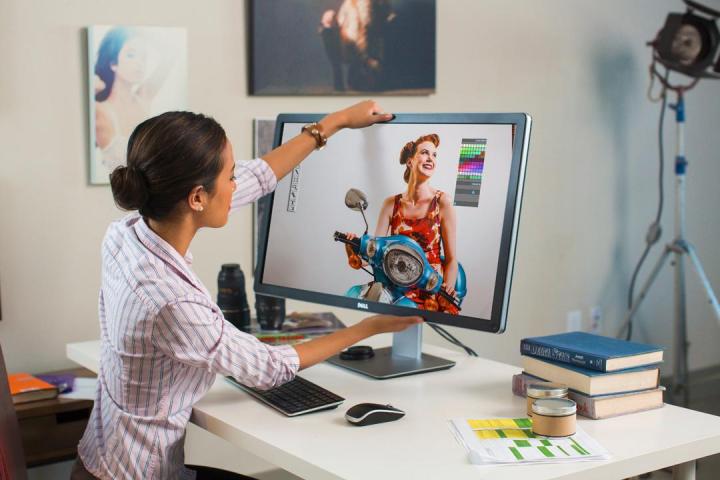
The average user may wonder, though: How does 4K may help or hinder day-to-day use on a computer? Everyone knows the resolution is great for video and photo editing as well as games, but what about editing documents and spreadsheets? Is there a benefit, or do the extra pixels cause problems?
Help! My monitor makes me sick!
Rumors that high-resolution displays might cause health problems have been bouncing around the Internet for some time now. They first took root in Apple’s own support forums, where users started to complain of eyestrain, headaches and even nausea while viewing early Retina displays. The issue really gained traction in 2012 with the release of the MacBook Pro with Retina. Several new posts complaining of similar issues appeared each month from June 2012 until the end of the year.

Several news outlets picked up the story. The New York Daily News and CBS ran articles alongside the announcement of the iPad 3 (the first with a Retina display) warning that iPads might cause “computer vision syndrome.” In October of 2012 the Telegraph ran a blog post that concluded “although we can’t prove it, there’s mounting concern that your [Apple’s] screens are harming our health.” And gadget reseller Gazelle published a blog post claiming “many consumers report health issues from the Retina display.”
Sounds damning, right? On closer look, though, these accusations seem thin and sensational. Apple is no longer alone in the pixel density game, yet I had a hard time finding similar complaints about 4K monitors or high-resolution Android devices. In fact, even the articles from NY Daily New and CBS concluded Retina displays might help despite the eye-catching headline they ran under.
High resolution is easy on the eyes
4K will not make you go blind. Increased sharpness may, in fact, be better for your health. Gary Heiting, optometrist and senior editor of the website AllAboutVision, made that clear. “Increasing screen resolution so it exceeds the discriminating ability of the eye lowers the risk of strain,” Dr. Heiting said, “by making objects and print more defined and comfortable to focus on.”
Determining whether a particular resolution “exceeds the discriminating ability of the eye” is difficult because our retinas don’t output convenient, easily understood parameters and not all eyes are the same. Only a few doctors have tried to place a hard figure on the maximum pixel density the human eye can discern.
Users started to complain of eyestrain and even nausea while viewing early Retina displays.
Dr. Bryan W. Jones, a retinal neuroscientist at the University of Utah, conducted one such analysis. He concluded a person with 20/20 vision couldn’t discern more than 287 pixels per inch at a distance of 12 inches. If the same person were to instead view a display from 24 inches (a more typical distance for desktop use) the maximum discernible density drops to just below 150 PPI.
What really causes eyestrain has little to do with cutting-edge technology. Display brightness is one prominent factor. A display that’s too dim or too bright for your environment can cause squinting either to let in or block excess light.
Sitting at an appropriate distance is also important. The U.S. Occupational Safety & Health Administration recommends office workers sit at least 20 inches away from any computer display. Leaning closer to better see small text is a natural instinct, but it’s also counter-productive because the human eye must work hard to bring objects that close into focus.
This is where a tenuous relation to resolution can be made. Images and text that aren’t scaled will appear smaller on a 4K monitor that on others, and that may trigger the urge to lean in. Owners need to fight that instinct and rely instead on the scaling features built into operating systems and Web browsers.
28 inches is the sweet spot
While 4K has no inherit health complications, users may have more trouble adjusting to it with some monitors than others. That’s because 4K, which is shorthand for 3,840 x 2,160 resolution, is used in displays of various sizes. The pixel count always remains the same, but a 28-inch monitor won’t be a dense as a 24-inch screen. Each pixel will be larger, that means less scaling is required to make text readable.
The difference is noticeable. A 24-inch 4K display offers 183 pixels per inch, but a 28-inch 4K monitor has just 157 pixels per inch. This means each pixel on the 28-inch monitor is about 15 percent larger than on the 24-inch screen and, as a result, text and images will naturally appear 15 percent larger as well. That’s like switching from a 12-point to a 16-point font.

A 32-inch display has an even more dramatic effect, increasing size by about 30 percent relative to a 24-inch alternative, but the size causes pixel density to drop below 140 PPI. This reduces clarity, a problem we’ve noted in few 32-inch 4K monitors we’ve reviewed. A 28-inch model is the current sweet spot between size and clarity because it exceeds the maximum discernible pixel density for most users, but can also render text at a readable size without excessive scaling.
What about Apple’s Retina iMac? Its 5K 27-incher has just under 220 pixels per inch. That’s way more than Dr. Jones’ analysis suggests is needed, but it also ensures people with better than 20/20 vision won’t be able to discern pixels even when sitting a bit too close to the display. Subjectively, I am able to notice the difference between it and a 4K 28-inch monitor, though only when each displays extremely fine text.
No reason to worry
The summary is simple. A 4K display is no more likely to cause eyestrain than a 1080p alternative. In fact, it’s greater clarity is an asset. Eyestrain can still occur, but if it does it’s because of excessive brightness, improper positioning or other factors, not the resolution. So lean back and enjoy. Your eyes will thank you.
Image credit: Wikimedia/Akcph


